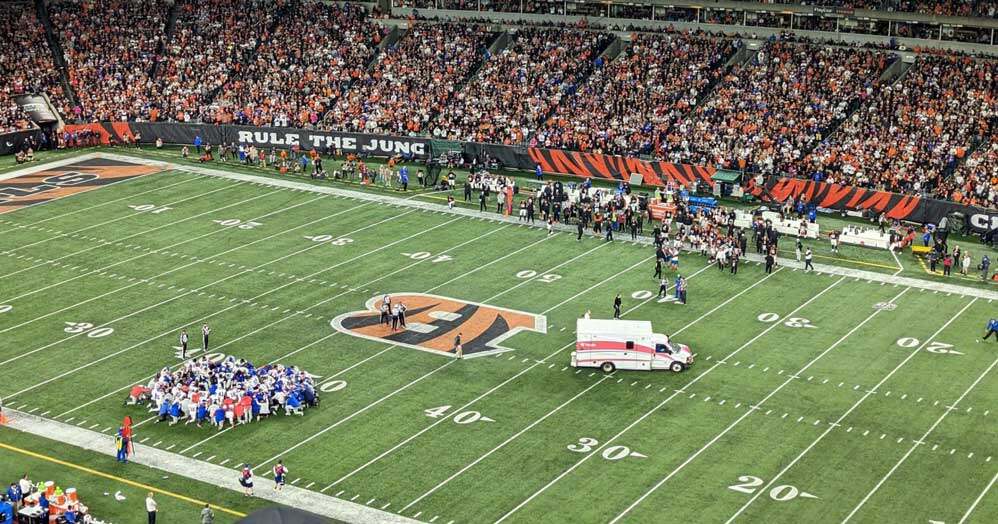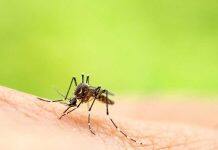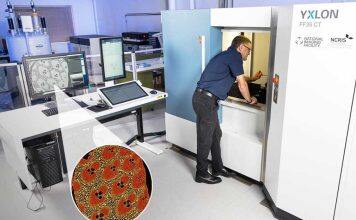A routine tackle in an NFL game on Jan. 2 almost turned fatal when Damar Hamlin of the Buffalo Bills was injured during a play, leading to cardiac arrest.


After popping up briefly after the play, Hamlin suddenly collapsed. Within seconds, Paycor Stadium, the home of the Cincinnati Bengals, went from a raucous crowd to hearing a pin drop as Hamlin lay unresponsive on the ground, requiring immediate external defibrillation to restart his heart.
This appears to have all the characteristics of commotio cordis. The NFL’s chief medical officer said that is a possibility, but doctors are investigating every possible cause.
Commotio cordis is the result of blunt trauma to the heart and is one of the leading causes of sudden cardiac death in youth sports. Fatal blows to the heart occur predominately in young athletes with an average age of 13.
Commotio cordis causes the heart to go into ventricular fibrillation, leading to pump failure. Although rare, this condition is fatal unless immediate resuscitation is conducted. Currently, commotio cordis still occurs despite the use of chest protection.
As a PhD student in biomedical engineering, I specialize in commotio cordis. My colleagues and I research how we can create safer chest protectors and safety regulations to prevent this tragic incident from occurring in sports globally.
While commotio cordis predominately occurs in youth sports, it can happen at all ages. Survival rates have increased over the years, but commotio cordis is still often fatal.
The perfect storm
Previous pig model studies established a series of conditions that must be met simultaneously in order for commotio cordis to occur:
- The impact must occur over or around the heart,
- the impact speed ranges from 48 to 80 kph (30 to 50 mph), and
- the impact occurs during the vulnerable period of the cardiac cycle which is approximately 20 milliseconds in length, just before the peak of the T-wave on an electrocardiogram.
The only known treatment for commotio cordis is immediate defibrillation, and the quicker an athlete’s heart can be electrically restarted, the higher the chances of their survival.
Developing new commotio cordis injury metrics
In 2021 our lab group developed new injury metrics for commotio cordis safety which provided the analysis of measuring rib cage deformation from impact.
The National Operating Committee on Standards for Athletic Equipment (NOCSAE) has established chest protector safety protocols to prevent against commotio cordis, and while they are not perfect they exist for baseball and lacrosse. Unfortunately, these regulations are absent for both hockey and American football.
They are urgently needed to prevent incidents occurring in all levels of sport, and our lab continues to pursue these goals of safety for all. We believe that, in addition to measuring force from impact, the inclusion of rib deformation would greatly improve the accuracy and effectiveness of these injury metrics. We also believe the inclusion of hockey and football in commotio cordis safety standards would help prevent these injuries.
Identifying vulnerable impact locations
Piggybacking on our initial commotio cordis injury metric study in 2021, our lab was able to identify potentially vulnerable impact locations over the heart which are currently not considered as a point of emphasis in commercially available chest protection on the market.
Using simulations, we were able to recreate these injuries and designed heat maps that overlay the chest of individuals to really highlight where the most dangerous locations may occur. We found that impacts slightly offset of the heart resulted in high strain values of cardiac tissue elements.
It is important to note that this location becomes exposed quite easily from athletic movement in which the chest protector may move around on the body of the athlete.
Optimizing commotio cordis safety standards
Recently, our lab group collaborated with cardiologist Stephan Rohr’s lab at the University of Bern in Switzerland. We conducted a study to identify further ways to optimize commotio cordis safety standards, while improving on the current regulations. This research is currently under peer-review.
To our knowledge, this is the first study to report on peak strain values that can be expected to occur at the level of the left ventricle of the heart during commotio cordis — inducing impacts for different age groups. The results from this study may contribute to the understanding of the cellular mechanisms responsible for commotio cordis, alongside sport safety and equipment regulations.
Our lab group is committed to ensuring we can reduce instances of commotio cordis. To make sports safer for people of all ages, and prevent the tragic loss of athletes on our playing fields, we will keep investigating the fundamental mechanisms and developing novel countermeasures.
Recent events may increase awareness of this rare but serious injury, and help promote improvements in protective equipment in many sports.
Grant James Dickey, PhD Student in Biomedical Engineering, Western University; Haojie Mao, Assistant Professor/Faculty of Engineering/School of Biomedical Engineering/Mechanical and Materials Engineering, Western University; Kewei Bian, PhD Candidate, Department of Mechanical and Materials Engineering, Western University, and Sakib Ul Islam, PhD Candidate, Department of Mechanical and Materials Engineering, Western University
This article is republished from The Conversation under a Creative Commons license. Read the original article.
*** Expert Insight reflects the perspective and scholarly interest of Western faculty members and is not an articulation of official university policy on issues being addressed.








































